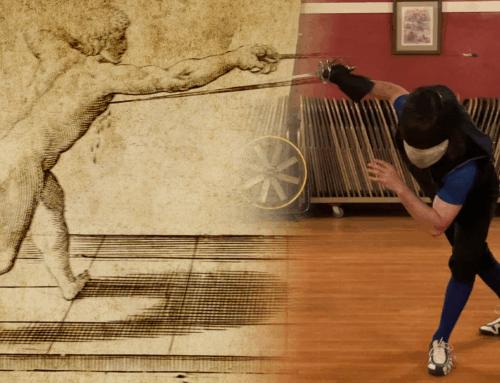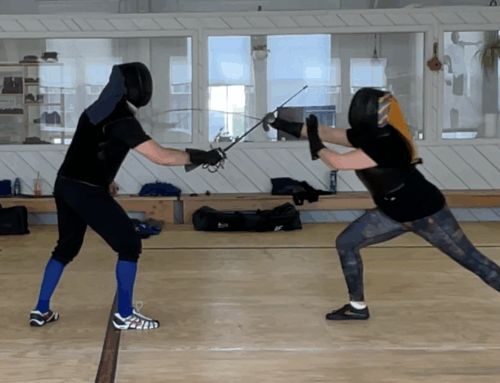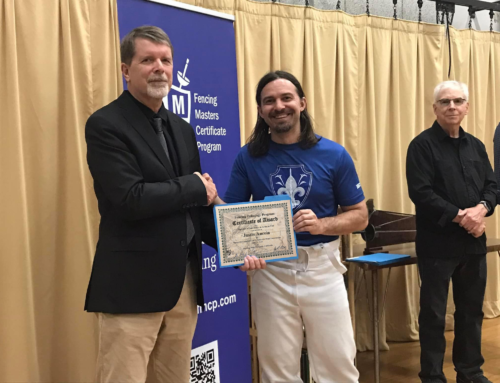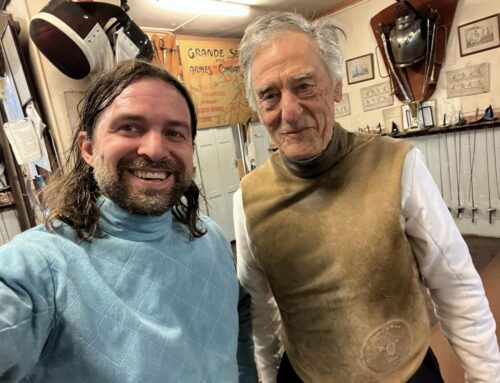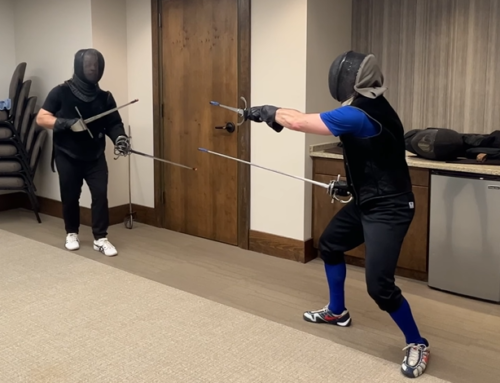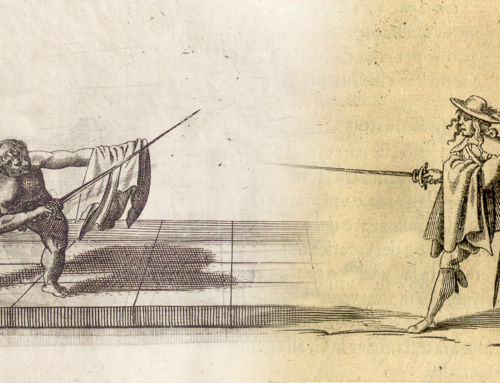Today we’ll be looking at the plays in Plate 8 of La Schermaby Francesco Ferdiando Alfieri. You can snag a copy over on Amazon if you want to follow along.
You can also find the rest of my Alfieri & other historical rapier research over in the Historical Fencing section.
The first two plays we looked at were pretty standard bread & butter Italian rapier plays, starting off with basic find-gain-attack on the inside and outside lines, and then some alternate plays.
In Chapter VIII we move away from lunges and work on passing steps which are a great way of closing more distance than a lunge. They also tend to be a little easier for fencers with bad knees.’
Alfieri starts off talking about how common firm foot attacks (aka lunges) are in duels. He’s a big fan of the lunges, but also says fencers shouldn’t ignore passes as they “disturb and distort” the enemy and travel with greater force.
Alfieri says you should “carry on passing in a straight line until you reach your opponent’s body, without stepping offline and without retreating…”
If you’re a right handed fencer and take your guard, a passing step would be moving forward from your on guard position so your left foot is now forward (as shown in the plate).
The Plays
Play #1.
Gentleman 15 moves in quarta (inside line guard) and finds & gains Gentleman 14’s sword. Gentleman 14 attempts to perform a cavazione (disengage) and strike Gentleman 15 on the outside line. As the cavazione is performed, Gentleman 15 turns his hand into seconda (outside line guard) and, instead of a lunge, takes a passing step and strikes his opponent.
This play would also work if Gentleman 15 performed a lunge in seconda during the cavazione instead. Alfieri doesn’t give a reason for a passing step over the lunge.
Play #2.
Gentleman 15, approaching in quarta, could feint to the inside in quarta and then wound on Line B in seconda under Gentleman 14’s sword arm.
Alfieri leaves out what Gentleman 14’s doing, but we can assume that he buys the feint and goes for a parry, giving Gentleman 15 the tempo and open line to strike. The strike in seconda should still be with a passing step in this scenario, though one could do it with a firm footed lunge.
Play #3.
This play was a bit problematic for me, so bare with me as we roll through this.
Gentleman 15 could “knock the sword to the outside, with reason as he does not have time to perform a cavazione” and then deliver a mandritto tondo (horizontal cut from right to left) or a riverso tondo (horizontal cut from left to right) to the head via Line A.
This bit is interesting because what “knock the sword to the outside.” I interpret this as a beat (a hard strike to the blade that knocks the opponent’s sword off line).
But who’s outside? Gentleman 15’s or Gentleman 14’s? After working through this, it felt most natural to beat on the inside line which would knock Gentleman 14’s sword to their outside line. From there it’s easy to perform a riverso tondo. A mandritto tondo would work if you put a moulinet at the start of it. The cuts would be delivered while making the passing step.
In SCA context, performing a thrust after the beat would be cleaner.
The second part that tripped me up in this play is the phrase “with reason as he does not have time to perform a cavazione…” When I originally read this play I thought Alfieri had switched form talking about Gentleman 15 to Gentleman 14 and the text was victim to bad grammar.
Then I watched the Kron Rapier Study Group interpretation of this third play. They have Gentleman 14 finishing his cavazione to which Gentleman 15 performs a beat from the outside line (which knocks Gentleman 14’s sword further to the inside line). From there Gentleman 15 can perform the cut to the head while passing to the left foot.
After watching their video and rereading the text, I think they’re correct. It’s a bit of poor writing on Alfieri’s part (or maybe lost translation), but Kron’s interpretation makes sense. Knocking the blade to the inside line while stepping to the outside line is much much safer and makes both cuts more natural to perform.
I’d love to hear other people’s thoughts on the play, however.
Additional Notes
One that that the plate shows but isn’t described at all is Gentleman 15’s offhand. In the plate the left hand is used to grasp Gentleman 14’s sword. Doing so keeps Gentleman 15 safer as Gentleman 14 can’t easily free his sword to exchange with a wound of his own.
We can’t grasp blades or the guard in the SCA, but an SCA fencer could put his hand on the guard to keep themself safe from attack. No one likes a double kill ‘cept the dude that got hit “first.”
Also I’m highly amused by the backwards B in the plate (it’s not backwards in the previous two plates).






